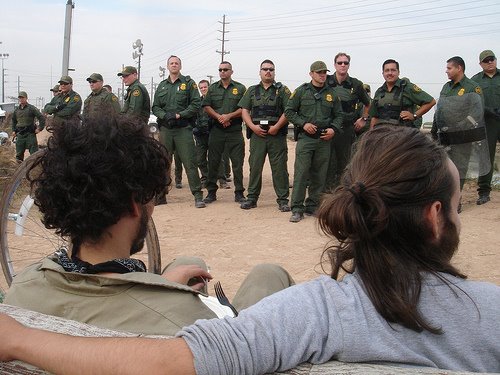By JAMES C. McKINLEY Jr.
Published: July 28, 2010
New York Times: http://www.nytimes.com/2010/07/29/us/29border.html
TUCSON — Dr. Bruce Parks unzips a white body bag on a steel gurney and gingerly lifts out a human skull and mandible, turning them over in his hands and examining the few teeth still in their sockets.
The body bag, coated with dust, also contains a broken pelvis, a femur and a few smaller bones found in the desert in June, along with a pair of white sneakers.
“These are people who are probably not going to be identified,” said Dr. Parks, the chief medical examiner for Pima County. There are eight other body bags crowded on the gurney.
The Pima County morgue is running out of space as the number of Latin American immigrants found dead in the deserts around Tucson has soared this year during a heat wave.
The rise in deaths comes as Arizona is embroiled in a bitter legal battle over a new law intended to discourage illegal immigrants from settling here by making it a state crime for them to live or seek work.
But the law has not kept the immigrants from trying to cross hundreds of miles of desert on foot in record-breaking heat. The bodies of 57 border crossers have been brought in during July so far, putting it on track to be the worst month for such deaths in the last five years.
Since the first of the year, more than 150 people suspected of being illegal immigrants have been found dead, well above the 107 discovered during the same period in each of the last two years. The sudden spike in deaths has overwhelmed investigators and pathologists at the Pima County Medical Examiner’s Office. Two weeks ago, Dr. Parks was forced to bring in a refrigerated truck to store the remains of two dozen people because the building’s two units were full.
“We can store about 200 full-sized individuals, but we have over 300 people here now, and most of those are border crossers,” Dr. Parks said. “We keep hoping we have seen the worst of this, of these migration deaths. Yet we still see a lot of remains.”
The increase in deaths has happened despite many signs that the number of immigrants crossing the border illegally has dropped in recent years. The number of people caught trying to sneak across the frontier without a visa has fallen in each of the last five years and stands at about half of the record 616,000 arrested in 2000.
Not only has the economic downturn in the United States eliminated many of the jobs that used to lure immigrants, human rights groups say, but also the federal government has stepped up efforts to stop the underground railroad of migrants, building mammoth fences in several border towns and flooding the region with hundreds of new Border Patrol agents equipped with high-tech surveillance tools.
These tougher enforcement measures have pushed smugglers and illegal immigrants to take their chances on isolated trails through the deserts and mountains of southern Arizona, where they must sometimes walk for three or four days before reaching a road.
“As we gain more control, the smugglers are taking people out to even more remote areas,” said Omar Candelaria, the special operations supervisor for the Border Patrol’s Tucson Sector. “They have further to walk and they are less prepared for the journey, and they don’t make it.”
Mr. Candelaria said the surge in discoveries of bodies this year might also owe something to increased patrols. He noted that some of the remains found this year belong to people who died in previous years. But Dr. Parks said that could not account for the entire increase this year. Indeed, the majority of bodies brought in during July, Dr. Parks said, were dead less than a week.
Human rights groups say it is the government’s sustained crackdown on human smuggling that has led to more deaths.
“The more that you militarize the border, the more you push the migrant flows into more isolated and desolate areas, and people hurt or injured are just left behind,” said Kat Rodriguez, a spokeswoman for the Coalición de Derechos Humanos in Tucson.
Read more: http://www.nytimes.com/2010/07/29/us/29border.html

No comments:
Post a Comment